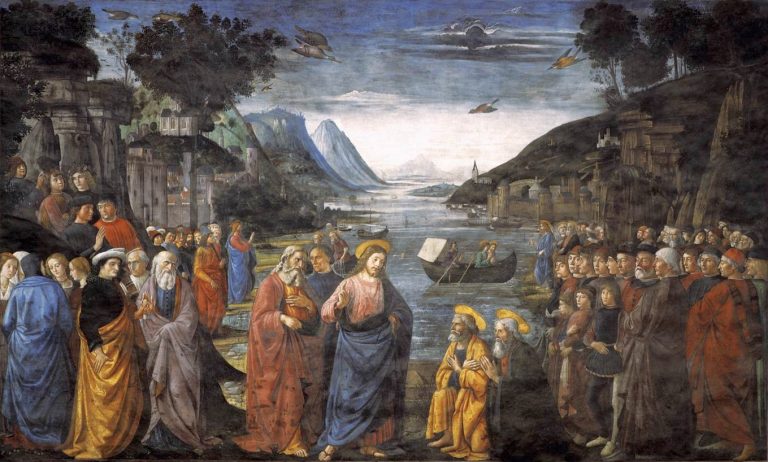By Edward Sri [social-share]
Dr. Edward Sri is professor of theology and Scripture at the Augustine Institute’s Master’s in Catechetics and Evangelization program in Denver, Colorado. He is the author of numerous books, including God with Us: Encountering Jesus in the Gospel of Matthew.

For the Jewish people, the number twelve was much more than a dozen. This sacred number brought to mind the twelve tribes of Israel which descended from the patriarch Jacob’s twelve sons. These twelve tribes were the foundation stones upon which the nation of Israel had been built. Jesus drew upon this traditional symbolism. By going among his numerous followers and pulling twelve men aside to be his close associates, Jesus was sending an important message. Without saying a word, this action of choosing twelve men for special duty would have said, “The New Israel is here with me and these twelve men!” This action alone could have signaled that all the Jewish hopes for a renewed Israel were coming to fulfillment in Jesus’ movement.
Therefore, when Jesus chooses twelve apostles, he’s symbolically expressing his intention to rebuild Israel—to reconstitute Israel around himself with the apostles as the central leaders.
The word “apostle” means “one who is sent.” An apostle represents the one who sends him, and shares in that person’s authority. Matthew’s Gospel draws our attention to this important point by an intricate display of literary art. Using a technique called “chiasm,” Matthew draws a number of parallels between what Jesus does in 9:35–38 and the mission he gives the apostles in 10:1–8. Jesus preaches the kingdom and heals the sick (9:35), and he sees the people are like sheep without a shepherd (9:36) and in need for God to “send out” laborers to them (9:38). To address this need, Jesus chooses “the twelve” apostles (9:38).
All of this parallels exactly in reverse order what comes next in Matthew’s narrative. Matthew lists the names of “the twelve” apostles (10:2) and sends out those apostles (10:5) as shepherds to the “lost sheep” of the house of Israel (10:5) so that they may preach the Gospel of the kingdom and heal the sick just as Jesus did (10:7–8).
In a chiasm’s structure, what is most important is what is in the middle of all the parallels. That’s what the narrator is trying to emphasize. At the center of these parallels in Matthew 9–10 is Jesus’ choosing twelve apostles and giving them authority (10:1–2).
The theme of Jesus’ authority is important for Matthew. In the opening chapter, he demonstrates Jesus’ messianic authority as a true Son of David with his royal lineage traced in the genealogy. Matthew 2 emphasizes Jesus’s authority in his fulfilling many ancient Jewish prophecies. Matthew 3 shows Jesus’ authority as the anointed King when the Spirit descends upon him at the Jordan River. In Matthew 4, Jesus exercises his authority over the devil, defeating him in the three desert temptations. In Matthew 5–7, Jesus establishes his authority in his teachings in the Sermon on the Mount as the people recognize he teaches with authority (7:29), and in Matthew 8–9 he manifests his authority over the storms, the sea, disease, infirmities, and even demonic spirits. Matthew 1–9 is all about demonstrating Jesus’ messianic authority through his words and deeds.
But in Matthew 10, that very authority of Jesus is now being shared with the twelve apostles. After the Pharisees accused Jesus of working with Satan (9:34), Jesus summoned the twelve apostles to be the leaders of the renewed Israel he was building.
To emphasize the reality of the apostle’s authority, Jesus went on to say to them, “He who receives you receives me” (Mt. 10:40). Invested with the authority of Jesus himself, the apostles’ role as representatives of Jesus is very clear: If you wanted to accept him, you had to accept his apostles. Imagine what would happen if someone said to Jesus, “I want a relationship with just you, not your apostles. . . . I like you, but I can’t stand Peter. . . . I’m willing to follow you, Jesus, but I can’t accept the leadership of James and John”? Jesus would say that whoever receives his apostles receives him. In fact, Luke’s Gospel incorporates another teaching of Jesus on this point. Jesus also says to the apostles, “Whoever receives you, receives me. And whoever rejects you rejects me” (Luke 10:16). That’s how closely Jesus associates himself with his twelve apostles!
This is why we today are called to accept the shepherding of the modern-day apostles, the bishops, who stand as the successors of the original twelve (cf. CCC 861–62). By receiving their guidance and teaching, we allow the Good Shepherd himself to guide our lives through his representatives here on earth.













